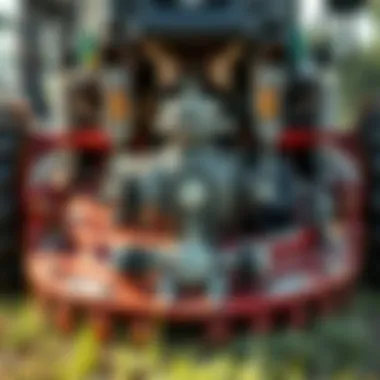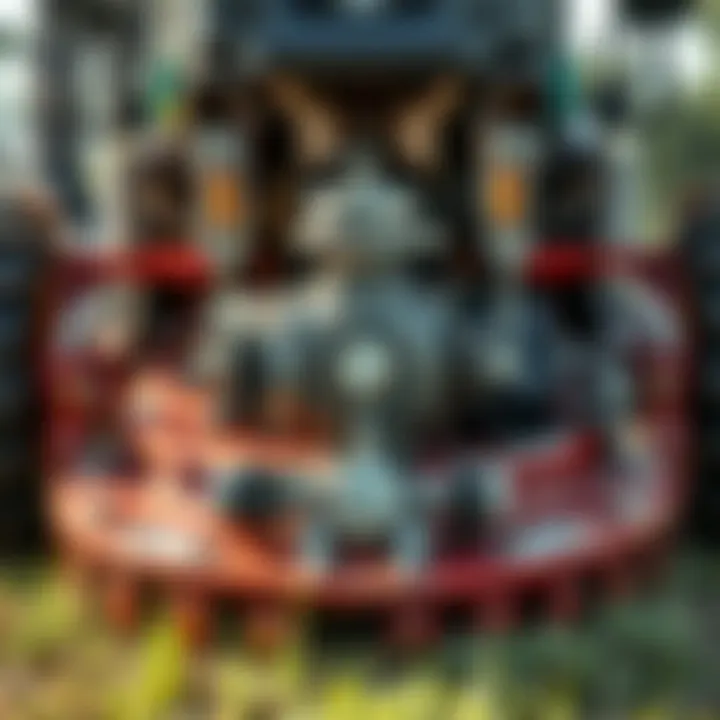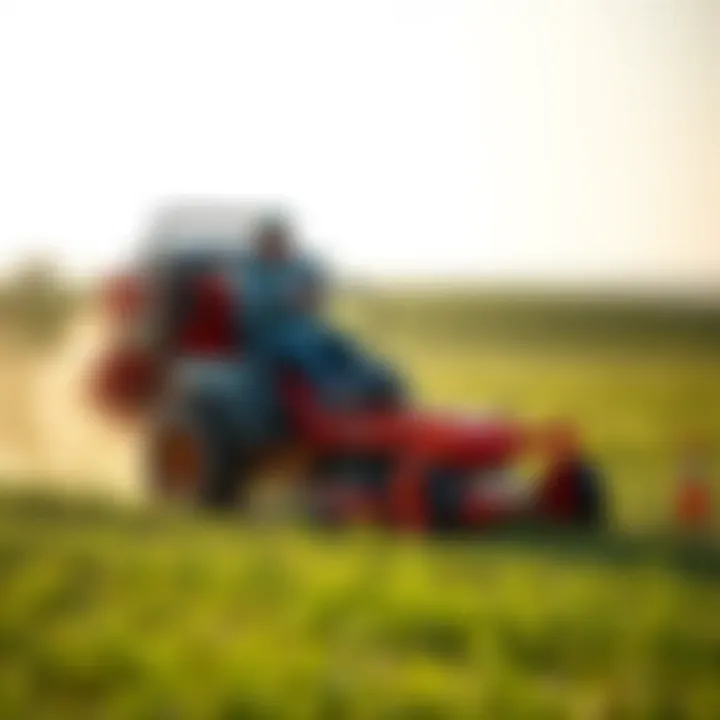The Evolution and Efficiency of Motorless Mowers


Intro
Motorless mowers have found their way back into gardens and fields, breathing new life into an ancient practice that seemed to fade into obscurity. This resurgence is no mere fad; it represents a transformative shift towards more sustainable and thoughtful gardening practices. As we navigate through the complex dance of modern agriculture, it's vital to recognize how these devices stand apart from their noisy, fuel-guzzling counterparts.
The heart of the motorless mower beats with a philosophy steeped in tradition yet adorned with contemporary relevance. By consciously reducing our environmental footprint, these tools not only cut grass but also enhance ecological balance. This article will explore the ins and outs of motorless mowers, diving into their mechanical principles, practical advantages, and how they can fit seamlessly into today’s agricultural landscape.
Topic Overview
Definition and Importance
Motorless mowers, often powered through human effort, employ simple yet effective mechanisms to cut grass and maintain gardens. Unlike their motorized counterparts, they offer a quiet, eco-friendly alternative that requires no gas or electricity. These devices vary from push reel mowers to scythes, making them accessible for all types of gardeners, from hobbyists to seasoned farmers.
The importance of these mowers lies not only in their efficiency but also in their potential to foster a deeper connection with nature. They require no mechanical intervention, encouraging a more mindful approach to gardening and farming.
Brief History and Evolution
Motorless mowers emerged in the early 19th century, with the introduction of the first reel mower. These devices revolutionized how we approached grass cutting, eliminating the labor-intensive methods of the past. Over the decades, advancements in materials and design allowed for more efficient and user-friendly models, yet the core principles remained unchanged.
With the global shift towards sustainable farming in the 21st century, motorless mowers have resurfaced, appealing to environmentally-conscious consumers who appreciate their historical roots. The environmental concerns caused by gas-powered mowers have only accelerated this trend, making motorless options more appealing than ever.
Key Techniques and Innovations
Sustainable Farming Practices
Using motorless mowers promotes practices that align with sustainability. These include:
- Reduced Carbon Footprint: The absence of fuel or electricity diminishes greenhouse gas emissions.
- Biodiversity Promotion: By mowing at varied heights, these mowers help maintain diverse grasslands and habitats.
- Soil Health: Manual mowing allows for closer attention to the soil structure, encouraging better practices like compost placement and organic amendments.
Advanced Agronomic Technologies
While the technology in motorless mowers may seem simple, innovations have still emerged. Many are being designed with lightweight materials, like aluminum and advanced composites, making them easier to maneuver. Furthermore, incorporating ergonomic handles enhances user comfort, reducing fatigue and making mowing a more pleasant experience.
Practical Applications
Step-by-Step Guides
To effectively implement motorless mowers in your gardening routine, consider following these steps:
- Assess Your Lawn Size: Smaller lawns generally suit push mowers, while larger areas might benefit from walk-behind or rotary styles.
- Choose the Right Tool: Select a mower based on your grass type and maintenance preferences. For example, scythes may be more effective for tall or dense grasses.
- Mow Regularly: Consistent mowing encourages healthy growth, preventing plants from going to seed and promoting a lush lawn.
- Consider Seasonal Timing: Adjust mowing frequency seasonally; grass grows more in spring and summer and requires less attention in fall and winter.
Case Studies or Real-World Examples
Several farms have successfully adopted motorless mowers as part of their sustainable practices. For instance, Green Acres Organic Farm in Oregon employs push mowers to maintain their vegetable patches, promoting soil health and reducing their carbon footprint. A community-focused initiative in Vermont encourages local gardeners to use scythes, creating a unique sense of camaraderie while emphasizing environmental responsibility.
"Motorless mowers are not just machines; they are tools for cultivating a more sustainable future."
As we explore the myriad benefits of motorless mowers, it becomes clear that their significance extends beyond mere efficiency. They represent a fusion of history and innovation in the world of agriculture that can inspire a greener tomorrow.
Prelims to Motorless Mowers
Motorless mowers represent not just tools for lawn care, but symbols of a return to methodologies that respect our environment. As society grapples with rising concerns about sustainability, these devices have taken center stage, heralding a movement towards eco-friendly gardening practices. Understanding motorless mowers, their design intricacies, and their historical significance can enrich farmers and gardening enthusiasts’ appreciation of these implements. This section endeavors to peel back the layers of motorless mowers, exploring their definition and context, which contributes to their renewed popularity and relevance today.
Defining Motorless Mowers
Motorless mowers, as the name implies, are mowing devices that operate without any motorized components. Examples of these include manual reel mowers, scythes, and sickle bar mowers. Each of these tools relies on simple mechanical principles where human effort drives their functionality.
- Reel Mowers: These consist of a set of blades that rotate on a horizontal axis. When pushed, the motion of the wheels turns the blades, cutting grass in a scissor-like fashion. Their efficiency is notable for maintaining a clean, even cut.
- Scythe Mowers: Known for their long, curved blades, scythes are wielded manually and provide a good workout. They excel in cutting tall grasses and weeds but require skill to use effectively.
- Sickle Bar Mowers: Although often associated with machinery, the manual versions operate on a similar principle to the reel mowers but use a longer blade that slides back and forth.
Motorless mowers come in various shapes and sizes to accommodate different types of grass and garden setups. Their key appeal lies in their simplicity and reliability, allowing for a cleaner cutting process without the noise or pollution generated by gas-powered options.
Historical Context
Historically, the advent of the motorless mower can be traced to the early agricultural practices of humankind. Before motors changed the landscape in the early 20th century, the scythe was a primary tool for mowing grass and harvesting crops. For centuries, farmers relied solely on manual tools, which encouraged a deeper connection to the land and its seasonal rhythms. As industrialization took off, motorized mowers began to dominate. Their convenience and speed overshadowed the advantages of manual options.
However, in recent decades, a shift has been observed. The environmental impact of gas-powered tools became clear, stirring conversations about sustainable practices. The re-emergence of motorless mowers is emblematic of larger trends: a desire for quieter, cleaner methods of maintaining landscapes. This renaissance fuels discussions among gardeners and farmers about the best practices aligned with eco-conscious values.
"In an age defined by quick fixes, motorless mowers invite us to slow down and engage directly with our environment, fostering a mindful approach to gardening."
The history of motorless mowers shows us that progress doesn't always mean advancing technology. It can also mean revisiting and refining simpler methods that have stood the test of time. As we delve deeper into their principles of design, advantages, and practical applications, understanding this foundation gives us the tools to harness innovation while respecting legacy.
Principles of Design
The design principles of motorless mowers form the backbone of their functionality and sustainability in lawn care. Understanding these principles is crucial for anyone interested in maximizing efficiency while minimizing environmental impact. In many ways, the smart design of these mowers translates into practical advantages for users, making it easier to embrace eco-friendly practices in their gardening routines.
Mechanical Mechanics
When delving into the mechanical mechanics of motorless mowers, we witness a harmonious blend of physics and practical engineering. Unlike their gas-powered counterparts, which rely on complex engines, motorless mowers utilize fundamental mechanical principles to achieve effective grass cutting. The mechanics often involve a simple push mechanism, allowing for direct human power to create the cutting action. This design reduces gas emissions and noise pollution, crucially aligning with modern ecological values.
One key component is the cutting blade arrangement, which operates on principles of sharpness and rotation. The blades are finely tempered and arranged in a way that optimizes surface area contact with grass, yielding a clean cut while preserving grass health. This efficiency means less wear and tear on the mower over time, contributing to sustainability in another dimension by lengthening usage periods before replacements are required.
Types of Motorless Mowers


Motorless mowers come in various shapes and forms, each embodying unique designs that cater to different gardening needs. These types include reel mowers, scythe mowers, and sickle bar mowers. Each type has distinct advantages and the ability to serve various gardening styles effectively.
Reel Mowers
Reel mowers are in the limelight for their simplicity and ease of use. Their design features a series of blades attached to a cylindrical reel that rotates as the mower is pushed forward. This mechanics creates an effective shearing action that results in a clean and precise cut.
The standout feature of reel mowers is their ability to maintain the health of your grass by providing a clean cut that minimizes stress on the plants. This is particularly beneficial for homeowners looking to foster a lush lawn. Additionally, their straight-forward design means that they require little maintenance. Just regular blade sharpening and wheel folding should suffice, allowing users to tackle lawn care without the worry of complicated engines and fuel types. However, they can be less effective on thicker grasses or in overgrown areas, which may require more powerful tools.
Scythe Mowers
Scythe mowers tap into ancient gardening traditions while serving modern communities. Featuring a long cutting blade attached to a wooden or metal handle, this mower operates primarily with a sweeping motion, efficiently cutting through taller weeds and grasses.
One major advantage of scythe mowers is their versatility; they can tackle various terrains and types of growth. The long reach also allows one to mow in hard-to-reach areas, making them a practical choice for irregular landscapes. On the downside, they typically require more physical effort and practice to master the technique than their reel counterparts. Nevertheless, those who perfect the art of scything can achieve stunning results.
Sickle Bar Mowers
Sickle bar mowers represent a balance between traditional hand tools and modern needs. They incorporate a series of reciprocating blades that work back and forth to slice through grass and weeds. This design allows for efficient cutting of tall grasses and even small brush.
The primary advantage of sickle bar mowers lies in their ability to handle dense growth, making them a popular choice for farmers and landscapers who maintain larger fields or rough terrain. Additionally, they can be used in conjunction with tractors for more extensive projects. However, the sickle bar may require more upkeep, as the moving parts can be subject to wear and tear.
Advantages of Using Motorless Mowers
The popularity of motorless mowers has been reviving in recent years, and the reasons behind this resurgence are compelling. Motorless mowers not only offer an effective way to maintain lawns and gardens, they also have a multitude of advantages that cater to the needs and values of both environmentally-conscious individuals and budget-minded homeowners. Understanding these benefits can help reinforce the decision to transition from conventional motorized equipment to more sustainable alternatives.
Environmental Benefits
Motorless mowers play a significant role in fostering eco-friendliness in gardening practices. One of the most notable environmental advantages is the absence of emissions. Unlike conventional gas-powered mowers, which spew out pollutants that contribute to air quality degradation, motorless options such as reel mowers and scythes operate without any fossil fuels. This translates into less carbon dioxide released into the atmosphere, which is crucial for battling climate change.
Additionally, motorless mowers promote biodiversity. Many homeowners notice that grass clippings, when left on the lawn, provide nutrients back to the soil. This is particularly handy in maintaining a lush and healthy lawn without resorting to chemical fertilizers that could potentially harm local flora and fauna. Therefore, by opting for motorless mowers, gardeners can actively contribute to a healthier ecosystem.
Key Highlights of Environmental Benefits:
- No emissions: Cleaner air, no harmful pollutants.
- Nutrient recycling: Grass clippings enrich the soil without chemicals.
- Noise reduction: Quieter operation benefits both users and neighborhoods.
Economic Considerations
Cost is often a decisive factor for individuals when selecting gardening tools. Motorless mowers shine in this aspect. First, the initial investment is often lower compared to motorized machines. Electric and gas mowers can set you back significantly due to their hefty price tags and ongoing maintenance costs.
A motorless mower needs far less upkeep. There are generally fewer parts prone to breaking or needing replacement. Maintaining a motorized mower can include oil changes, spark plug replacements, and dealing with complex engines. In contrast, one might find that sharpening the blades of a reel mower or lubricating a few moving parts is about the extent of the required maintenance. This can save both money and time in the long run.
Economic Advantages:
- Lower purchase price: Accessibility for a wider audience.
- Reduced maintenance costs: Time and money saved when keeping the mower in good condition.
- Long-term savings: The absence of fuel and electricity bills helps budget planning.
User Experience
User experience metrics often lie deeper than just the mower’s functionality; they encompass comfort, ease of use, and overall satisfaction. Motorless mowers, particularly reel mowers, offer an intuitive design that makes them easy for just about anyone to use. Colloquially speaking, they are as simple as pie.
The physical engagement that comes with using a motorless mower often translates into a more fulfilling user experience. For many, mowing the lawn remains a form of exercise — a way to reconnect with nature and reduce stress. The absence of engine noise also allows for a peaceful outdoor experience, where the sounds of nature can be enjoyed. As a bonus, the need for regular physical activity promotes health benefits, especially for those who may spend long hours in sedentary office jobs.
User Experience Highlights:
- Ease of use: Straightforward designs hone in on utility.
- Connection to nature: Increased mental well-being is noted.
- Physical benefits: Engaging in beneficial exercise without the noise.
Challenges and Limitations
The use of motorless mowers certainly brings forth a plethora of advantages, yet grappling with their challenges is essential to paint a complete picture. Many enthusiasts find themselves awash in romantic notions of simplicity and sustainability when picturing motorless mowers amidst a sun-drenched lawn. However, the practical realities can present hurdles that require thoughtful consideration and adaptation.
Physical Effort Required
Using a motorless mower often necessitates a considerable amount of physical exertion. Unlike their motorized counterparts, which whirr effortlessly, these mowers demand a labor-intensive approach. Early morning dew or an overheated afternoon sun can turn mowing into quite the workout.
For instance, reel mowers, revered for their precision, rely on the user’s strength to push the device across the grass. A sprawling yard may feel more like a marathon than a leisurely stroll, particularly for individuals who may not be physically fit. Age and health also factor into the equation, as those with limited mobility or stamina might find the task increasingly daunting.
Consider the following points about physical effort in mowing:
- Strain on Muscles: Continuous pushing can lead to fatigue, especially without proper breaks.
- Endurance Requirement: Tasks can become taxing over time; yards require regular maintenance and if left to grow long, they become more challenging to cut.
- Frequency of Use: Those who envision motorless mowers as a viable daily option must weigh the likelihood of exhausting workout sessions against the attractiveness of low-cost mowing.
Provided the aforementioned points, one must contemplate their physical abilities and local lawn size before opting for a motorless mower.
Maintenance and Durability Issues
Motorless mowers may be celebrated for their green credentials, but they aren't free from maintenance woes. Ironically, while minimalist in mechanics, these machines require regular upkeep to ensure longevity. Parts can wear down, dull, or even rust if not cared for properly.
For example, the blades of a reel mower must be sharpened periodically to maintain cutting efficiency. Neglecting this often leads to uneven cutting and could even damage the grass. Furthermore, many users find that these mowers can be tricky to repair, especially if they lack experience with mechanical components.
Here are a few considerations concerning maintenance and durability that come into play:


- Frequent Sharpening Needs: To preserve the effectiveness of the blades, sharpening is essential at least a few times each season, more often if mowing frequently or dealing with tougher grasses like fescue.
- Material Quality: Often made of steel, blades can rust if not dried off properly after mowing wet grass. Keeping them clean requires diligence.
- Part Replacement: Should there be a part malfunction, sourcing and replacing it might not be as straightforward as one anticipates.
Despite these challenges, a commitment to regular maintenance can lead to a fruitful relationship with a motorless mower. The practice also emphasizes the principles of sustainability, where careful handling extends the lifespan of tools while fostering an understanding of mechanical functions.
"A stitch in time saves nine," as they say, stands true in the world of motorless mowers. Addressing maintenance needs promptly can save considerable effort and ensure continued performance.
Practical Applications
Motorless mowers serve a dynamic role in various settings, proving their worth not just in environmental sustainability but also in practical utility. Understanding these applications can help gardeners and landscapers utilize these tools effectively, marrying efficiency with green practices.
Residential Use
In residential settings, the charm of a motorless mower lies in its simplicity and sustainability. Households looking to maintain lawns can appreciate the benefits of these mowers as they often promote a healthier lawn. Using a motorless mower allows homeowners to cut grass without emitting fumes, ensuring a cleaner neighborhood atmosphere.
Here are some key benefits:
- Quiet operation: Unlike loud gas-powered mowers, motorless versions operate quietly, enhancing peace in the neighborhood.
- Green credentials: Using a mower that requires no gasoline or electric power reduces homeowners’ carbon footprints.
- Low maintenance: They often require less upkeep, allowing users to focus more on garden aesthetics rather than mower repairs.
Many homeowners find that the physical act of mowing with a manual tool is not just a chore but a small form of exercise. As one vibrant gardener put it, "Mowing with my reel mower feels like a dance with nature—no hassles, just the rhythm of the grass."
Commercial Use Cases
In commercial applications, motorless mowers cater to organizations striving to promote sustainability while also cutting costs. Parks, golf courses, and larger estates increasingly integrate these manual mowers into their maintenance protocols. The benefits extend beyond simple cost savings; they reinforce corporate responsibility toward eco-friendly practices.
Consider the following for commercial applications:
- Cost-effectiveness: Lower operational costs can be achieved by avoiding fuel expenses and reducing how often repairs are needed.
- Brand image: Businesses that utilize motorless mowers often enhance their reputations as environmentally conscious entities.
- Durable blades: The build of these mowers regularly allows users to sharpen blades rather than replace motors, which adds to their lasting value.
For instance, a golf course in California successfully transitioned to motorless grooming methods, citing not just savings but a surprising uptick in grass health, leading to better playing conditions. It’s proof positive that even in high-demand commercial environments, motorless mowers have their place.
Community and Environmental Projects
Motorless mowers are perfect for community-driven projects where sustainability and collaboration are key. Community gardens, urban parks, and grassroots environmental initiatives have found them becoming indispensable. These projects often aim to not only beautify an area but also to teach local residents about sustainable practices and the importance of ecological balance.
Some engaging features of using motorless mowers in these settings include:
- Educational opportunities: Workshops on how to use these mowers can engage communities and promote eco-awareness.
- Volunteer engagement: Mowing doesn't require gas and is user-friendly, making it easier for volunteers of all ages to get involved.
- Biodiversity support: Hand-cutting grass prevents damage to the soil structure, allowing for better water retention and fostering local flora and fauna.
In a recent community project in Oregon, volunteers used motorless mowers to maintain a local park. By fostering teamwork while mowing without noise pollution, they turned the effort into a bonding experience. This example underscores how these tools can play a vital role in community resilience and environmental stewardship.
By recognizing and harnessing the potential of motorless mowers in residential, commercial, and communal settings, users not only benefit from improved lawn care but also contribute to a greater cause of sustaining our environment.
"In every slice of grass, we nurture a greener future."
Comparison with Motorized Alternatives
In examining the landscape of lawn care tools, a thorough comparison of motorless mowers with their motorized counterparts is both essential and enlightening. With every passing year, more gardeners and farmers are turning their backs on revving engines, opting for a quieter and more eco-friendlier approach. The shift isn't merely a trend; it signifies a changing attitude towards sustainability, efficiency, and personal engagement with the land.
Operational Efficiency
When it comes to operational efficiency, motorless mowers often shine in specific contexts that motorized mowers may overlook. For instance, while motorized mowers can chew through thick grass at a rapid rate, they can also suffer from overheating and require regular fuel supply and maintenance.
Conventional motorized mowers demand gasoline, electricity or heavy gasoline engines, presenting a significant drawback when evaluating overall efficiency. Conversely, motorless mowers rely solely on human effort and can produce a finely cut lawn without the noise and pollution of engine-operated versions.
Key points in operational efficiency include:
- Energy Use: Motorless mowers demand no external energy sources, making them eco-friendly.
- Noise Levels: They operate silently, ideal for residential areas where tranquility matters.
- Control of Cutting: Users have more precise control over their mowing height and path.
Ironically enough, while motorized options might save time on larger properties, their associated costs and the environmental impact they bring about could turn that efficiency on its head.
Maintenance Requirements
Maintenance is another vital area where motorless mowers often outperform motorized ones. The upkeep of gas-powered mowers can be time-consuming and costly. Oil changes, filter replacements, and spark plug replacements are the routine sorrows faced by many motorized mower owners throughout the mowing season.
By contrast, motorless mowers, such as reel mowers or scythe mowers, require far less attention. The most routine maintenance involves a quick check of the blades and ensuring they remain sharp. Oftentimes, a simple sharpening is all that's needed to keep them in top shape.
Essential considerations regarding maintenance include:
- Lower Maintenance Costs: No need for oil, gas, or extensive repairs means a smaller budget is needed.
- Extended Lifespan: With proper care, a motorless mower can last for many years with very little wear and tear.
- Simplicity: The less complex design means fewer things can go wrong.
Cost Analysis
Lastly, the financial aspects of motorless versus motorized mowers can't be overlooked. Upfront costs may appear daunting when considering motorized mowers due to their extensive features and performance capabilities. However, a deeper dive into the long-term expenses reveals an important story.
Motorless mowers typically have a much lower initial investment and fewer recurring expenses. Here’s a quick breakdown:
- Initial Costs: While a good-quality motorized mower may set you back significantly, a robust reel mower can often be procured for a fraction of that price.
- Fuel and Electricity Costs: Motorized mowers continually siphon resources each time they're used.
- Insurance and Maintenance Costs: With motorless alternatives, the absence of complicated components often translates into lower insurance and repair costs.


In essence, while motorized mowers might entice with their speed, they could end up costing significantly more in the long run based on fuel consumption, repairs, and maintenance while the motorless options reflect responsible spending aligned with sustainable practices.
In summary, while motorless mowers may not match motorized mowers in sheer power or speed, they hold their ground when operational efficiency, maintenance, and cost are considered. As more individuals become aware of their impact, the demand for these simpler tools continues to rise. This shift promotes not only individual responsibility for gardens but also echoes a more profound commitment to fostering a healthier environment.
For more insights, visit Wikipedia or the National Gardening Association.
Sustainable Practices in Lawn Care
As cities grow and the climate warms, the push for sustainable practices in lawn care has become more crucial. Motorless mowers exemplify these principles by offering efficient alternatives to traditional motorized devices. By emphasizing eco-friendly methods, they not only tend to our green spaces but also ensure that these practices benefit both the environment and the local community.
With an increasing awareness of climate change, organic practices are gaining traction among gardeners and farmers. This approach minimizes reliance on harmful pesticides and synthetic fertilizers while promoting biodiversity. By integrating motorless mowers, maintainability becomes a vital aspect. Grass cutting techniques become a part of a holistic gardening routine that draws upon natural resources. The benefits begin with reduced carbon footprints and extend to healthier soils and ecosystems.
Integrating Motorless Mowers in Lawn Care Routines
Motorless mowers are not just an alternative; they can be essential tools in a sustainable lawn care routine. They allow gardeners to engage in a more hands-on method of maintaining their yards, promoting physical activity while offering a quiet, pollution-free solution for lawn maintenance. Integrating these tools involves more than simply using them.
Tips for integration:
- Schedule Regular Mowing: Prioritize mowing schedules based on grass growth cycles. Most grasses thrive when cut at specific intervals, allowing for optimal nutrient absorption.
- Adjust Mowing Heights: Tailoring the cutting height enhances the grass's health. By leaving the grass longer, it can develop deeper roots resulting in a stronger lawn.
By meshing these practices with motorless mowers, lawn care transforms into an art form of balance and sustainability. Users often find a deeper connection with their gardens, experiencing firsthand the joys and benefits of organic maintenance.
Complementary Practices
Motorless mowers shine when paired with other sustainable practices. These practices, like composting, mulching, and natural fertilization, create a complete eco-system that enhances the garden's overall health and vitality.
Composting
Composting converts kitchen scraps and yard waste into nutrient-rich soil. This practice nurtures the soil, reducing waste while emitting fewer greenhouse gases. A key characteristic of composting is its ability to improve soil structure, enabling better water retention and drainage. By decomposing organic matter, compost brings life back into soils stripped of nutrients by chemical fertilizers. It’s a beneficial choice because it promotes biodiversity in earthworm populations, offering natural aeration.
However, potential disadvantages include the time commitment needed to properly manage a compost pile, which can deter some gardeners from fully embracing the method. Yet, those who invest the time typically find the benefits far outweigh the drawbacks.
Mulching
Mulching involves covering the soil surface with organic materials like leaves, grass clippings, or wood chips. This practice conserves moisture, suppresses weeds, and enhances soil quality as the mulch breaks down. Why is mulching popular? It’s cost-effective and reduces the need for frequent watering, perfectly complementing motorless mowers that can cut and distribute clippings as mulch.
However, the unique feature of mulching could be in its transition time. For instance, incorporating mulch might initially require more labor, but in the long run, it saves time and lowers maintenance. Still, some gardeners feel uneasy about aesthetics, as excessive mulch can appear messy.
Natural Fertilization
Natural fertilization relies on naturally occurring substances, such as animal manure or green manure crops, to enrich the soil. This process enhances soil fertility, retains essential moisture, and stimulates beneficial microbial activity. The key benefit here is its sustainability; natural fertilizers reduce dependence on synthetic chemicals. This approach encourages a balanced ecosystem that supports plant growth without the risks associated with chemically synthesized fertilizers.
Moreover, with careful management, these fertilizers come with minimal downsides, although timing the application can prove challenging. Users have to ensure that the nutrients are adequately available for plants during their growing seasons. By fostering a rich soil environment, natural fertilization aligns perfectly with the ideologies behind motorless mowing.
In sum, combining motorless mowers with these sustainable practices can make a profound impact on the way we view lawn care. Each practice feeds into another, weaving a coherent tapestry of ecological responsibility while ensuring our lawns remain beautiful and productive.
Future of Gardening Equipment
The evolution of gardening equipment is not merely a tale of new gadgets, but rather a reflection of changing values and priorities among gardeners, landscapers, and agriculturalists. The future of gardening equipment lies heavily in sustainability, efficiency, and user-friendly designs. As environmental awareness rises, motorless mowers are gaining popularity as part of a broader trend emphasizing eco-friendly practices. This echoes a significant shift where gardeners are increasingly focused on reducing their carbon footprints while maintaining the beauty and utility of their green spaces.
Technological advancements play a crucial role here. New materials and engineering techniques promise to enhance the efficacy of motorless tools while also making them lighter and more adaptable to various gardening needs. The importance of this shift cannot be overstated, as consumers look for solutions that not only task efficiently but also align with a more sustainable lifestyle.
Trends in Garden Tools
Within the gardening tool landscape, several trends are emerging that suggest a future ripe with innovation:
- Sustainability: The trend towards sustainable gardening is seeing a rise in demand for tools that minimize ecological impact. Motorless mowers are at the forefront of this movement, offering a quieter, cleaner approach to lawn care without the emissions associated with gas-powered alternatives.
- Versatility: Garden tools are increasingly designed to serve multiple functions. A motorless mower is a prime example as it's effective not just for mowing but can also be integrated with attachment systems for other tasks, providing maximum utility without cluttering the garden shed.
- Ergonomics and User-Centric Design: Comfort is key. New designs focus on making tools easier to use without compromising effectiveness. This can include adjustable heights, cushioned grips, and lightweight materials, all aiming to lessen physical stress on the user.
Technological Innovations
Innovation is steering the future of gardening equipment in ways that were once only possible in science fiction. Among the notable advancements include:
- Advanced Materials: The introduction of high-strength plastic, lightweight metals, and composites lend durability while reducing tool weight. This innovation not only enhances the ease of use but also extends the lifespan of the products.
- Precision Engineering: Motorless mowers are being outfitted with precision cutting blades and gearing systems that allow for a sharper cut while requiring less physical effort. Innovations in blade design can lead to cleaner cuts that promote healthier grass growth.
- Smart Technologies: The integration of data tracking and smart devices is on the rise. While this trend is more rooted in powered tools, there's the potential for manual tools to also utilize smart technology for precision use, allowing users to monitor their gardening metrics more efficiently.
The resurgence and future of motorless mowers signify a pivotal moment in gardening practices. They draw a line towards a more sustainable, responsible approach and embrace efficiency without compromising the natural world. Understanding these trends and innovations will serve as a guiding beacon for those passionate about plants and the environment.
Finale
In drawing the curtain on our exploration of motorless mowers, it’s essential to highlight the significance of this topic, particularly in the current landscape where sustainability is at the forefront of agriculture and gardening practices. The evolution of motorless mowers reveals not just a return to simpler tools but a deeper understanding of what efficient and environmentally friendly yard maintenance can look like in a modern context.
Motorless mowers are impressively effective. They make use of basic mechanical principles yet yield fantastic results. No engines, no pollution, just the power of human effort combined with smart design. This combination not only reduces carbon footprints but also offers a quieter way to keep properties tidy, which is often a significant concern in residential areas.
Consider the implications for aspiring agronomists and enthusiastic gardeners:
- Cost Efficiency: Motorless mowers generally entail less financial outlay compared to their motorized counterparts, with lower maintenance costs and no fuel expenses.
- Environmental Health: Using these mowers reduces noise pollution and fossil fuel consumption, aligning gardening activities more closely with sustainable practices.
- User Experience: For many, the act of mowing becomes a therapeutic activity, a way to connect with nature and the land.
Moreover, these mowers serve as a bridge between traditional gardening techniques and innovative practices. They empower individuals and communities alike to take ownership of their landscapes while respecting the environment.
"Embracing motorless mowers means embracing a quieter revolution in caring for our green spaces, ensuring that we contribute positively to the environment while enjoying the simple pleasure of tending to our lawns and gardens."
Recap of Key Points
- Motorless mowers have a historical significance in gardening, offering a sustainable alternative to gas- and electric-powered machines.
- They provide numerous benefits, including environmental advantages, substantial economic savings, and an enriching user experience.
- Challenges, such as physical effort and maintenance, exist but can often be managed with proper care and technique.
- The future looks promising as trends continue to lean towards sustainability, making the use of motorless mowers increasingly relevant in various applications.
By reevaluating these tools, individuals can reclaim not only their lawns but also a sense of purpose and connection to the outdoors. The enduring charm and practical effectiveness of motorless mowers assure their place in the hearts of gardening enthusiasts, farmers, and environmentally conscious creators of green spaces.



